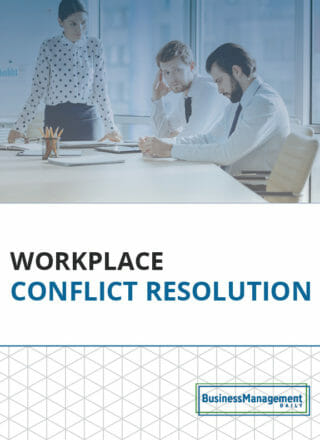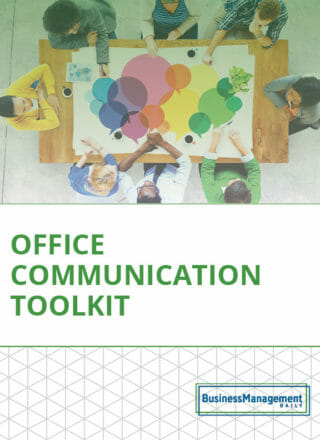Foolproof strategies to resolve conflict in the workplace
Conflict resolution is in everyone’s best interest when tensions arise in the workplace. Productivity, morale, and teamwork suffer when workers are upset or preoccupied with disagreements. The discord can affect the entire company culture as team members get drawn into taking sides or become discouraged by a toxic work environment. Increases in absenteeism and employee turnover may result.
Effective conflict resolution, though, faces challenges. Involved parties may cling tight to their point of view either out of conviction or to save face. Add the fact that hurt feelings and other negative emotions can run strong. Then, realize many workplace conflicts arise from a skewed reality caused by poor communication, misinformation, or erroneous assumptions.
How can team members move beyond these factors and resolve conflict? Let’s look at some conflict resolution strategies.
Communicate
Ditch “the silent treatment” and other passive-aggressive nonsense. Workplace conflict resolution demands effective communication. It takes courage to tackle conflict situations head-on, but such effort is vital to the resolution process.
If possible, involved parties should meet face-to-face in private. This setup allows better comprehension of body language and other clues about feelings and understanding.
Aim to define the root cause of the conflict. Sometimes, people are surprised to learn that what they consider the reason for a dispute is different than the thoughts of their adversary.
Individuals interpret events through different lenses. Or, they receive inaccurate or partial information rather than the whole story. Often, they make up their motives behind someone’s behavior.
Meet to clear the air and problem-solve together about how to move forward. Respect one another through active listening, appropriate language, and other professional behaviors. Figure out if you have similar goals but different ways of achieving them. Consider how your conflict may impact the team and how finding harmonious ways to work together would benefit everyone.
Sometimes, asking for a one-to-one conversation feels too intimidating or does not yield desired progress. Mediation from human resources or management can help. The third party can assist by acting as an impartial facilitator. This individual is not there to decide who is right or wrong.
Instead, the mediator gets sparring team members into neutral territory, encourages them to present their side without interruption, and moves them to think about how to handle conflict in the future. An “outsider” often points out common ground that angry individuals cannot see.
Also, the mere presence of a project manager or someone from the HR department can make people behave better and work harder at collaborating on resolution.
Improve conflict resolution skills
While a conflict-free work environment sounds ideal, such a utopia is a unicorn. The danger exists that places that aim for peace above all lose out on diversity of opinion because team members feel unsafe expressing their true thoughts. Unique ideas fail to be considered, and innovation suffers.
A better mindset is acknowledging that conflict sometimes occurs when people work together. “Fighting fair,” preserving relationships, and managing conflict are more doable goals than total elimination.
For starters, realize the importance of not letting grievances fester. For example, ask a colleague why you were not invited to a particular meeting rather than assume he is trying to exclude you maliciously. Perhaps it was a genuine oversight, or maybe he honestly thought he was saving you some time by not needing to attend.
An actual explanation, rather than what you envision, can guide further behavior. You may ask the office admin about getting on that committee’s invitation list. Or, perhaps you need to politely clarify to the co-worker that you want to attend any meeting for that project, even small gatherings.
The possibility also exists that upon hearing the agenda, you realize your presence would have been unnecessary — and you can thank him for his consideration!
When approaching someone about a potential issue, assume good intentions (as in innocent until proven otherwise). This way of thinking helps avoid “looking” for a problem. It also reduces hostile, escalating behavior such as yelling, swearing, name-calling, character-bashing, and dredging old grudges.
As much as possible, stick with personal observations and individual interpretations of events. People do not like it when others put words in their mouths or profess to know what is going on in their minds.
Likewise, avoid dragging others into matters unnecessarily. One thing is someone who can offer pertinent information that may assist with conflict resolution. Encouraging irrelevant others to add their two cents or choose sides is another.
The latter fuels problems in taking over the work environment. Conflict management becomes more challenging with more people involved as the original participants worry how apologizing or making concessions will affect their reputation.
This brings up a point to realize when handling conflict: The end result need not be a clear winner and a clear loser (though sometimes this scenario does happen). Instead, successful conflict resolution techniques focus on figuring out how to move forward.
Explore questions such as:
- Is it feasible for each side to gain its top priority?
- Can we agree to disagree?
- Is burying the hatchet possible, or are feelings too intense to forgive and forget?
- Might we best avoid conversations about politics or other controversial topics?
- What does each of us need from the other to put the incident behind us?
- How can we best keep our differences from affecting our ability to work together or bothering our team?
Develop emotional intelligence

Some people seem to have a knack for smoothing over conflicts or avoiding getting into them in the first place. Such individuals often possess a high degree of emotional intelligence — the ability to manage one’s own emotions and to understand the feelings of others.
Self-awareness and self-regulation are critical components of emotional intelligence (EI). This self-knowledge proves helpful in conflict situations.
For instance, someone sensing her blood pressure brewing during a conversation may leave the room temporarily to gain composure rather than saying something she knows she will regret later.
Or, perhaps a manager who has been up all night with a sick child realizes that lack of sleep has made him grumpy today. He may decide to postpone a scheduled discussion with an underperforming employee until a day when he can tackle it more calmly.
People with good EI also sense what others are experiencing. Their ability to empathize helps them understand another party’s feelings and point of view. Leaders value emotionally intelligent employees’ social skills, especially in tense group situations.
An emotionally intelligent team member may get sparring parties back on track by rephrasing their statements in neutral terms. Or, the person high in EI might pick up on someone being hurt by a comment and work to smooth things over.
Like communication skills, emotional intelligence is something that interested people can improve. Many business schools and community colleges offer classes, and plenty of online courses also exist. HR departments should look into bringing in speakers for seminars. And, of course, relevant books offer plenty of worthwhile suggestions.
Consider starting with the Daniel Goleman classic Emotional Intelligence: Why It Can Matter More than IQ.
Additional resources – Opens in new tab:
Types of workplace conflict and how to handle them
Workplace etiquette: The ultimate guide to professionalism
The 6 step workplace conflict resolution process





